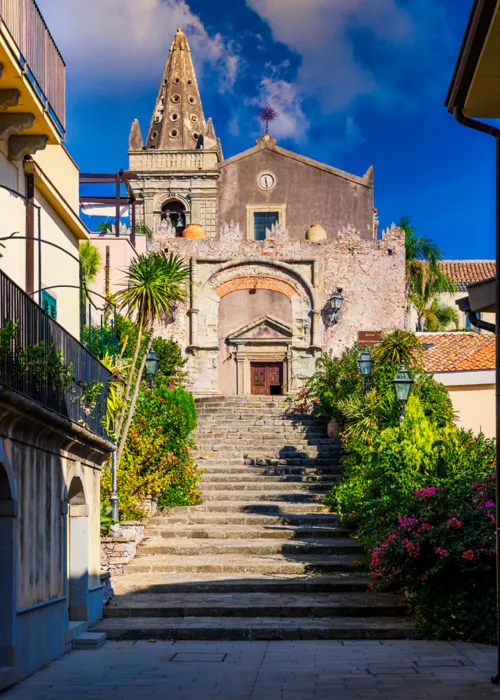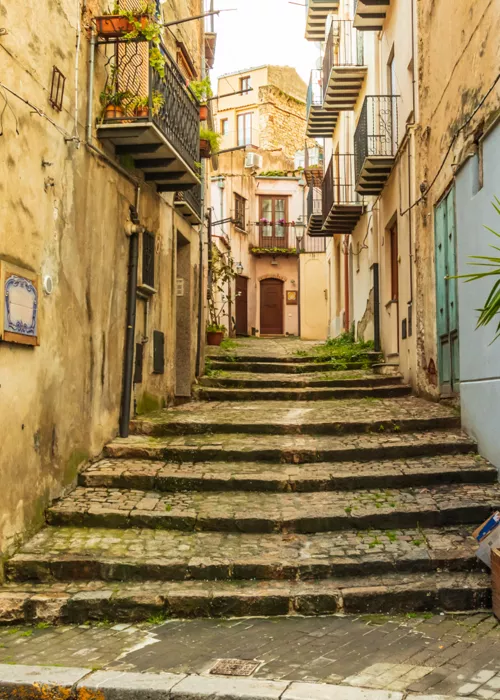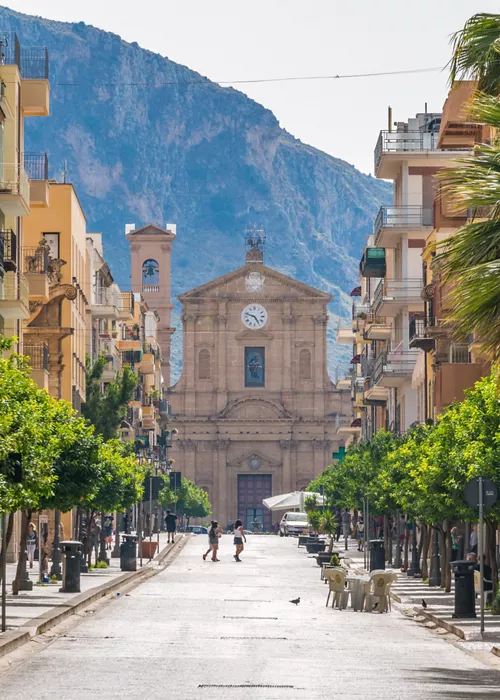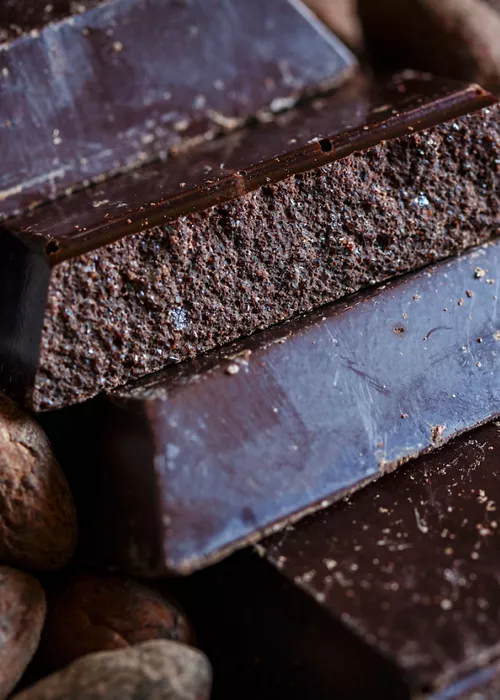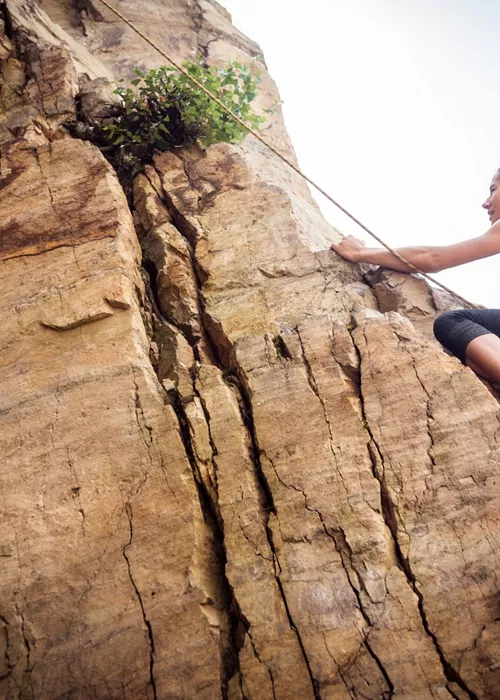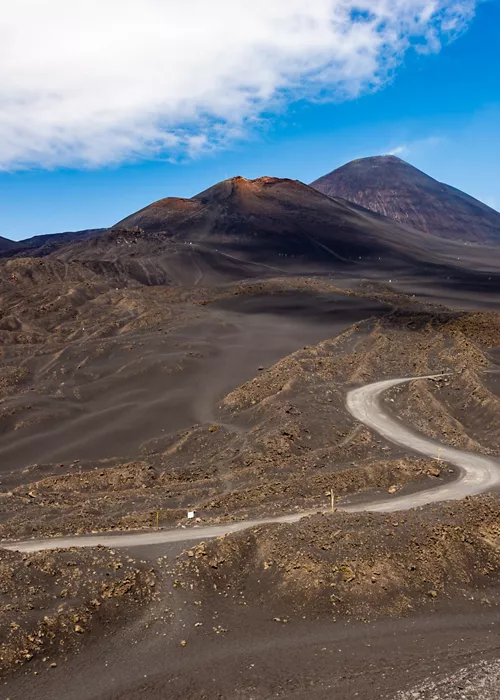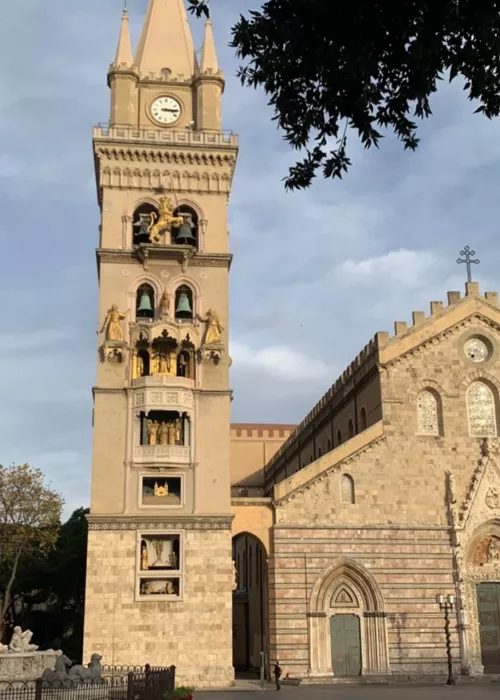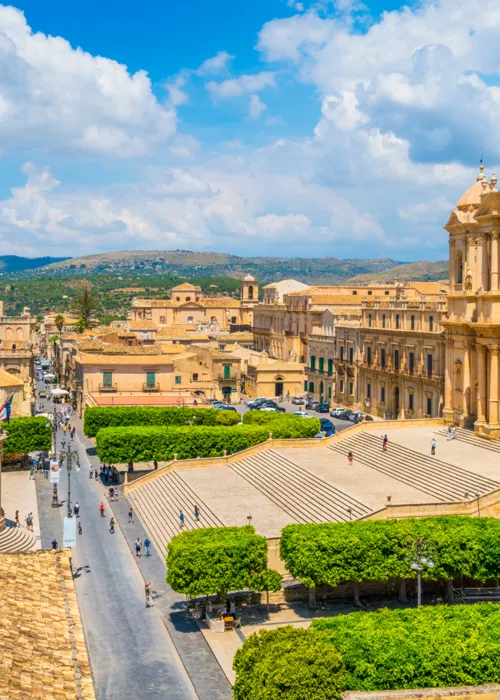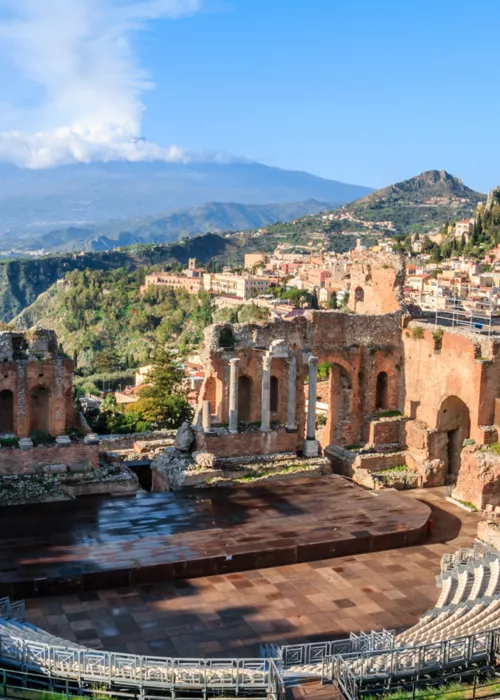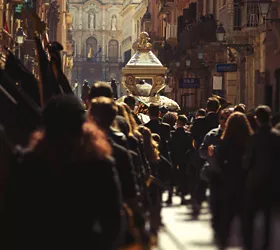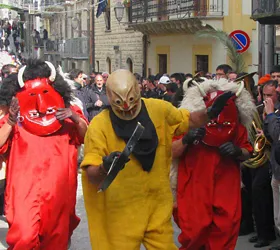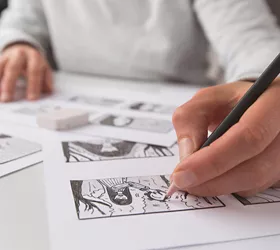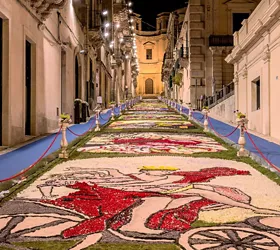3 Baroque Villages in South East Sicily
15 minutes

Beyond the popular UNESCO-listed Baroque towns of south east Sicily, there are many smaller offbeat villages with the same lavish architecture, minus the crowds. Discover three stunning Baroque villages, part of the ‘Borghi Più Belli d’Italia’ (most beautiful villages in Italy) list, and head outdoors to learn about prehistoric civilizations and ancient customs.
Ferla
Walk through ancient Medieval quarters to the Via Sacra, lined with five grand Baroque churches built after the 1693 earthquake. Uncover the ancient past of the Iblei mountains with a visit to the UNESCO-listed Pantalica necropolis
Top 5 things not to miss
- The rock-cut tombs in the Pantalica Necropolis
- Five Baroque churches along the Via Sacra
- Learning about Ferla’s green commitment
- Hiking along the Anapo and Calcinara rivers
- Food/Wine to taste: vota vota, stuffed focacce with a variety of fillings
Throughout history, beauty is sometimes born out of destruction. If an earthquake didn’t level much of south east Sicily in 1693, we wouldn’t have the stunning tardo-Baroque buildings that came to light during the reconstruction, putting the region on the map of visitors from all over the world.
Before that date, Ferla was a shapeless tangle of Medieval streets and rural cave-dwellings. Now, it’s home to dramatic Baroque buildings that rose from the rubble like a real-life phoenix.
Traces of pre-earthquake Ferla can still be found in ancient districts like Carceri Vecchie, with a tangle of back streets and alleys clinging to the cliffside.
This was our first encounter with Ferla, a village in the province of Siracusa, included in the ‘Borghi Più Belli d’Italia’ list. Children chasing a ball down the street, generations of women chatting on the doorstep, sitting on those white plastic chairs so common across Southern Italy. Shadows were lengthening, blades of light blossoming red and gold just as cats were taking their place on walls and ledges, signaling the day was coming to an end.
Just around the corner, we found ourselves in Via Vittorio Emanuele, one of the two main arteries around which 18th century Ferla was reconstructed. It is also known as the Via Sacra, housing five opulent Baroque churches. Starting from the southern end, the first we encountered was Santa Maria del Carmelo, with both Ionic and Doric decorative elements, followed by San Sebastiano Church a short distance away, with a statue by Michelangelo di Giacomo representing Saint Sebastian’s martyrdom right above the entrance portal, an exquisite example of Sicilian Baroque sculpture.
Right across the square, separated by a fountain, is the Chiesa Madre, decorated with the emblem of Ferla - a shield with a phoenix rising from the flames on one side, and on the other, a rearing lion under a ferula, a common shrub in the Iblei believed to be have given rise to the village name.

Walking north up the slope of the via Sacra, we quickly reached Sant’Antonio, the most spectacular and lavishly-decorated church in town, with a curved three-part façade that used to be topped by two bell towers, of which only one remains. We quickly managed to have a look inside, to the dome covered with frescos illustrating the Triumph of Saint Anthony, before we were ushered out as Sunday Mass was about to begin.
It was the time when late afternoon turns into evening, and the beating heart of Ferla was just outside. A local politician gave a speech, while people drank aperitivo outside. Further up the hill was the final church - Santa Maria, rarely open but housing an impressive wooden crucifix by Frate Umile da Petralia inside.

Ferla is also known as the ‘Porta di Pantalica’ (doorway to Pantalica), a UNESCO-listed necropolis dating back to the period between the Bronze and Iron Age. The entrance is just 11 km from Ferla, and most visitors just cover the short distance to the Belvedere where you can see rock-cut tombs all over the canyon wall.
Pantalica is a magical place suspended in time, where memories of an ancient past survive surrounded by wild nature, almost untouched by humankind since the site was abandoned almost 3000 years ago. It’s worth dedicating at least a few hours to exploring the area, descending all the way to the bed of the Anapo and Calcinara river, where the abundance of fresh water and the towering canyon walls made our ancestors feel safe and protected, deciding to call the place home.
Other sites worth checking out in Pantalica include the San Micidario village, with a collection of cave houses and a rock church dating back to Byzantine times, and the Anaktoron, the only stone building in Pantalica, believed to be the residence of the prince.
Ferla may have one foot in the past, but is also a place that looks at the future, and works hard to protect the environment. In 2014, the municipality inaugurated an innovative Ecostazione, a recycling and composting facility built with bio architecture techniques. In less than 10 years, the recycling rate rose from 4 to over 75 per cent, and launched other green initiatives such as the creation of an ‘energy community’, where excess energy from renewable sources is shared between members.
But there’s more. Wellbeing cannot exist without a healthy soul - for this reason, Ferla also created the first municipal Centro Olistico (holistic centre) in Italy, with spaces for yoga, massage, reiki and other holistic disciplines.
It seemed to be the ideal place to end this journey across time that took us through Ferla. From prehistoric stones to Baroque beauty, and all the way to a brighter future, where wellbeing of the planet and of our soul are paramount.
Ferla: Useful Information
Best time to visit:
Easter is a great time to visit for the picturesque Holy Week celebrations featuring parades and plays. Spring and Autumn in general are great times to visit as it’s not too busy and the weather is not excessively hot, allowing you also to enjoy the surroundings.
How to get there:
There is one daily AST bus from Catania and Ferla, taking 1 hour 45 minutes, also stopping at the airport enroute. Driving from Catania will take just over an hour.
Buccheri

This is the roof of the Iblei, a town where once snow was so abundant it started a unique industry. Try finding the ‘neviere’, and enjoy a walk through the historic center, between Etna views and Baroque architecture.
Top 5 things not to miss
- Sant’Antonio Abate Church overlooking the village
- The Baroque beauty of Santa Maria Maddalena Church
- Walking in search of the unique ‘neviere’
- Visiting a saffron farm and learning about its benefits
- Food/Wine to taste: award-winning olive oil
We had the road to ourselves. It was a sunny Sunday afternoon, but it looked as if no one was out. There were no cars, no bikes, not a single soul. We were riding our mountain bikes up a minor road in the interior of Sicily - our destination was Buccheri, the highest village in the Iblei Mountains at 820 meters above sea level.
The road climbed steadily, seriously testing our legs one switchback after another. All around us were the Iblei, a landscape of dry stone walls, olive and almond trees, prickly pears and patches of forest against a deep cobalt-blue sky. A faint hue on the horizon revealed that, indeed, we weren’t too far from the sea. After a particularly taxing climb, Mount Etna also came into sight, with its conical shape towering over the Iblei and the lowlands.
Shortly afterwards, we finally rode into Buccheri. Under our wheels, cobbles replaced tarmac - the unmistakable sign that we were indeed in a borgo - indeed, one belonging to the list of ‘Borghi Più Belli d’Italia’ (most beautiful villages in Italy).

The late summer sun shone over the houses, constructed with a combination of lava and sandstone, as it often happens as you get close to mighty Etna. Similarly to Ferla and Militello, Buccheri was also heavily damaged by the 1693 earthquake, and many churches were rebuilt in flamboyant Baroque style - like Sant’Antonio Abate Church, with a tiered colonnaded façade, overlooking the village from the top of a monumental staircase (you may find yourself humming the Rocky theme song as you walk up).
Another great example of Baroque architecture in Buccheri is Santa Maria Maddalena Church, with sandstone statues and Corinthian columns welcoming the visitors. The real marvel lies inside - a marble statue of Mary Magdalene by Antonello Gagini, one of the most notable Sicilian Baroque artists. In contrast, the Chiesa Madre looks simple and modest, with its partly-finished exterior and whitewashed stucco decorations inside.
Buccheri is surrounded by the largest expanse of woods in the Siracusa province, where with a little bit of patience you can find the neviere, where snow used to be processed into ice. As the highest village in the region, snow was once common in Buccheri - a local saying says “Buccheri cu la nivi è mpastatu, rrara è dd’annata ca nun-ha-nnivicatu” (Buccheri is plastered with snow, years when it doesn’t snow are very rare).
Before the arrival of refrigeration, snow was a rare commodity. All around Buccheri, it was collected and stored in the neviere, tiny dome-shaped buildings partly excavated underground, with an opening on the roof where snow is loaded, and a ‘door’ to extract ice blocks. The ice was used to make granite and gelati, and sold as far afield as Malta. The easiest neviere to find are the one right at the entrance of Buccheri when coming from Ferla, and another in the forest near the tiny Crocifisso church on the outskirts of the village.
Buccheri is a great destination for food lovers. In 2015, it won the award for best olive oil at Sol d’Oro, and in 2021 it was named ‘Best Food Destination’ by the World Food Organization. A great place to try local recipes is U’ Locale, a restaurant under an archway in the historic part of the village, with wild herbs, foraged mushrooms and rare products such as white beans from Etna. The owner also compiled a historic cookbook with recipes from the books of famed Sicilian writer Giovanni Verga, and one dish features on the menu every night.
Another place worth checking out is the Masseria Fortificata Lo Zafferaneto just outside Buccheri, a 19th century fortified farmhouse producing saffron, restored into a boutique hotel and restaurant. Saffron features frequently on the menu, and for those wanting to know more about it, it’s possible to join workshops or cooking classes to learn how saffron is grown, processed and used in recipes.
We ended our experience in Buccheri with a dinner at Lo Zafferaneto, with fluffy saffron ricotta drizzled with the tangy, award winning olive oil, and a magical saffron panna cotta for dessert. It was night by then, and we could just imagine the landscape around us - but somehow, we had found a way to experience it, immersed for a full day in the timeless nature of the Iblei mountains.
Buccheri: Useful Information
Best time to visit:
Spring is a good option for festivals and events - Easter is the time of Passiu Santu, a real-life representation of the Passion along the Via Crucis, attended passionately by the whole village. In May there’s a nature festival, with guides leading tours in the mountains around the village. September/October are also great times to visit, as the weather is usually still good.
How to get there:
Driving from Catania will take about an hour 15, otherwise the same bus connecting Catania and Ferla also continues to Buccheri, taking 2 hour 15
Militello in Val di Catania
There’s more than meets the eye in this fascinating small town - explore intricately decorated Baroque churches, marvel at sacred art in a crypt museum, and learn how Militello was ‘reborn’ after the 1693 earthquake.
Top 5 things not to miss
- Baroque Santa Maria della Stella and the Della Robbia altarpiece
- Sacred art museum in the cathedral crypt
- Guided tour to see rarely-visited churches inside
- Hiking to the Oxena river waterfalls
- Food/Wine to taste: Mostarda di fico d’India (prickly pear mustard)
Militello Val di Catania was the last Baroque village we visited, the last in a kaleidoscope of narrow streets, hilltop villages clinging onto mountainsides, Panda 4x4 zipping down alleyways - those images we all know and love. To be specific, it’s more of a small town than a tiny, two street village like the ones we had visited thus far, and it’s one of the 8 UNESCO-listed Sicilian Baroque towns, so we expected there would be plenty to see. It was also named as one of the ‘Borghi Più Belli d’Italia’ (most beautiful villages in Italy).
For our last Sicilian borgo, we wanted to go beyond the usual experience and try to delve deeper, walk through doors that are normally closed, and understand what lies beneath what we can see. There’s only one way to do that - with a guide.
We met Sebastiano one sunny afternoon, right around the corner from the Chiesa Madre, and we walked together to our first stop, the Church of Santa Maria La Vetere, on the edge of the Baroque historic center. There’s a clear date that marks a break in the history of Militello - January 11th, 1693, when a series of earthquakes leveled the town, alongside much of south east Sicily. ‘Old Militello’ used to be located further downhill, in a valley rich with natural caves, where Ancient Sicilians first settled. The new town was reconstructed at higher altitude, in an area that was believed to offer better resistance to shakes and tremors. This proved to be true, as modern seismologists confirmed it’s further from the fault line.
‘This is the only place where you can get an idea of what Militello looked like before the earthquake’ said Sebastiano, as he showed us Santa Maria la Vetere. The church itself dates back to Norman times, even though the entrance portal was added during the Renaissance, with some polychromatic reliefs picturing the Virgin Mary surrounded by angels and saints.
Only part of the right nave survives, the rest collapsed during the quake, bringing back to light a paleochristian necropolis that can be seen in the archeological site adjacent to the church. Sebastiano pointed out a cave-tomb topped by a grate, where corpses used to be placed to drain fluids and organs, turning them into mummies.
We walked back into Militello passing the Fountain of Ninfa Zizza, displaying a young maiden sprouting water from her breasts, surrounded by two lion face fountains and with an octagonal basin topped by a satyr mask. The fountain dates back to 1607, and was placed to commemorate the arrival of drinking water to the town. According to a local legend, Zizza was a young girl who fell in love with a young shepherd named Lembasi. She was betrothed to a rich landowner, but not wanting to betray her love she became a spring, and Lembasi was turned into a river.

A short distance away, we stopped at the Purgatorio Church, formally dedicated to saints Vito and Gregorio Magno, but named after the Confraternita del Purgatorio, a brotherhood that prayed for the souls of the recently departed in the hope they’d be able to pass through Purgatory quickly and reach the heavenly gates. The brotherhood was extremely rich, as families showered them with gifts and offers in exchange for prayers for their loved ones.
Sebastiano took a giant antique key out of his backpack and led us inside - where we could see with our own eyes how rich the brotherhood actually was. The simple exterior was in stark contrast with the lavish interior, with painted Baroque stucco decorations and a reproduction of the Purgatory mountain on the altar, covered with 24-carat gold leaf.

The decadent post-earthquake Baroque churches are almost always on top of a system of tombs and crypts, some of which were only made accessible in recent years. This is the case of the Chiesa Madre, dedicated to San Nicolò and SS Salvatore - its crypts house a sacred art museum, including gold and silverware, devotional objects, religious furnishings and vestments, paintings and more. The architect behind the museum was Giuseppe Pagnano, who combined the existing stone walls and arches with modern construction materials like concrete.
The marvels on display include objects from before and after the earthquake - we saw a limestone sculpture of dead Jesus dating back to the 15th century, intricate 18th century silverware, as well as a full collection of jewels offered by rich noblewomen after their prayers were answered. Another interesting exhibit was a book about chess techniques printed in 1617, believed to be the first one to describe the famous ‘Sicilian Defense’.
Our day in Militello was a whirlwind tour between Baroque churches and fountains, sunny piazzas and airy palazzos - Sebastiano uncovered the obvious layer by layer, showing us there’s always more than meets the eye. A spiral staircase in a corner of the Chiesa Madre led us to the roof, where we found ourselves above the terracotta rooftops of the city, with Etna watching us from afar. The unassuming entrance of Madonna della Catena church concealed a spectacular Baroque interior, with whitewashed decorations only picturing female saints.

However, the most spectacular surprise awaited us inside Santa Maria della Stella church. The Baroque exterior was beautiful, illuminated by the early-evening blue light, but inside we saw an exquisite ceramic altarpiece by Andrea della Robbia, representing the Nativity in the center, with God blessing the scene on the top and the Passion of the Christ on the other.
The altarpiece was placed in the ‘original’ Santa Maria Church, the one now called La Vetere, where we started our exploration earlier that afternoon. Luckily, it wasn’t damaged by the earthquake, and so it was moved to the newer Santa Maria della Stella when it was completed - where so many other people were able, and will be able, to appreciate it in all its beauty.
We thanked Sebastiano and walked back to our car, as the early evening ‘peak hour’ of locals strolling and drinking aperitivo was now in full swing. After a day spent exploring the past, trying to understand what lay beneath old buildings and churches, we felt like we’d been thrust back into present times.
However, to see a place, it’s not enough to participate in the merry-go-round of the living. Some places cannot be ‘seen’ - you need to breathe them, to embrace them with your entire soul. This, in a nutshell, was Militello in Val di Catania for us.
Militello in Val di Catania: Useful Information
Best time to visit:
Autumn and Spring are great times to visit Militello in Val di Catania, to enjoy mild weather and find plenty of accommodation options. Late Summer and early Autumn are great times to visit for events, like the Santa Maria della Stella festival on August 18th and the Sagra della Mostarda di Fico d’India (prickly pear mustard festival) in October.
How to get there:
There are two daily trains connecting Catania Centrale with Militello - travel time is approx 50 minutes. If you have a car, it takes about the same time to drive to Militello from Catania airport.
Article written about the experience of Margherita Ragg and Nicholas Burns.
Authors: Margherita Ragg and Nicholas Burns - The Crowded Planet



